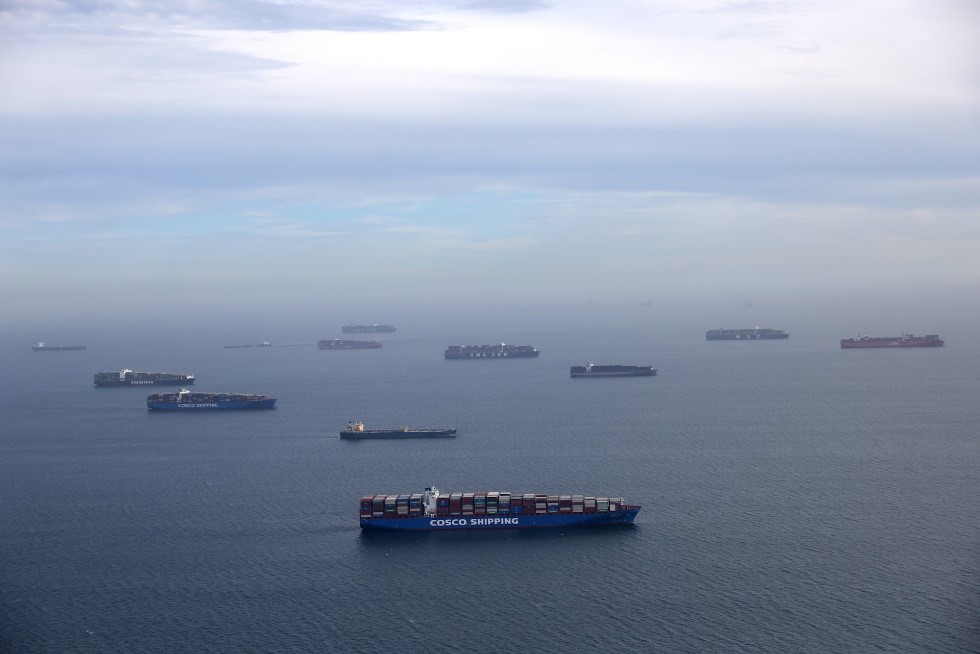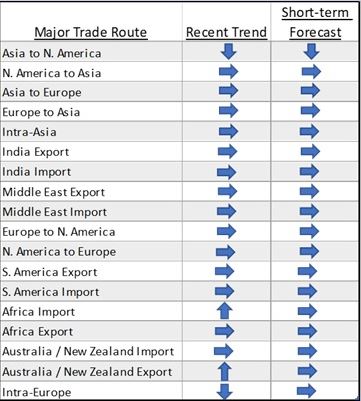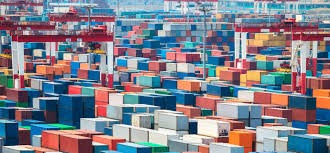Welcome to the second edition of our Moving Industry Bulletin. Every other month we strive to provide our customers and clients with an update on what we’re seeing on the ground that’s impacting the service delivery landscape, including global shipping disruption.
Our September Bulletin highlighted the increase in freight costs, decreased vessel capacity and container shortages. Two months later, these topics remain at the forefront causing further potential shipping disruption to our customers.
November’s edition covers the following areas causing further complexities and additional costs when delivering international door-to-door moving services:
- – Ocean vessel capacity constraints
- – Freight costs
- – Haulage constraints
- – Altered and reduced ocean carrier lanes
Ocean vessel capacity constraints
Most are now familiar with the pictures of vessel congestion at several major ports around the world.

Vessels waiting outside the port of Los Angeles, CA USA, to receive berthing space to offload cargo (photo credit: gCaptain)
While it may be assumed the cause is increased shipping demand, it would not be the root cause of current vessel capacity constraints being experienced. Shipping lines are not able to accept cargo due to the large volume of vessels waiting outside ports for a space to berth and offload cargo.
Maersk, the world’s largest container shipping company offering regular services to 374 ports in 116 countries, indicated that there are now 300 vessels laying idle outside ports waiting for their berthing space to offload cargo (see the Nov 2, 2021, Reuters article). Due to this congestion, it now takes 20-25% more fleet capacity to move the same number of containers. However, available vessel capacity is fully engaged. The full impact is a significant reduction in the number of containers being shipped compared to pre-pandemic volumes. This makes it more difficult to find vessel space for moving our customers’ personal effects internationally.
Almost all major ports are still struggling with congestion, storage space shortages and the removal of vessel capacity due to vessels waiting at ports. These factors are causing severe shipping disruption to both sailing schedules and vessel availability. In turn, causing substantial delays to shipments and additional costs.
Freight costs
As highlighted in September, ocean freight costs have increased dramatically in the first half of 2021. Beginning in October, the increases have begun to soften. While continued softening is anticipated, ocean freight costs will be subject to the ongoing effects of the pandemic expected to last through 2022.
Drewry*, a world leading independent global maritime advisory and research organization, publishes a Global Freight Rate Index indicating a slight decrease (-5%) in shipping container rates between September and October. However, this slight decrease should be viewed in the context of a Year-Over-Year index increase of 268%.
Drewry expects freight rates to fall in most of the East to West trade routes but stabilize in the North to South routes in November. They indicate freight rates on Transpacific Eastbound trade routes have already peaked and could ease over the coming weeks. Congestion at major ports in the U.S. and huge power cuts in China have also disrupted supply chains across the Pacific, but imports from Asia are expected to remain strong until January 2022. These factors give tremendous leverage to carriers to further increase rates. But they will refrain from doing so as any spike could attract scrutiny from regulators across the world. Moreover, carriers are still recording high profits in variance to losses, or marginal profits recorded over the past many years.
*Subscription required to access the content.
Cost trends in container shipping rates:

Source: Drewry Supply Chain Advisors; Global Freight Rate Index
Haulage constraints
Challenges around haulage resources and constraints are a worldwide issue, especially in hard-hit countries such as the United States and United Kingdom.
Haulage resources transport shipping containers to the ocean port after our customers’ effects are loaded into the container, or for delivery to our customers’ residence after arriving at the destination ocean port.
Haulage resource capacity is limited and demand is exceeding capacity in many countries. This is resulting in more time being taken to move containers to, and from, ocean ports – causing delivery delays as well as additional port storage, demurrage and detention charges for our customers. Additionally, the shortage of haulage drivers in many countries has led to increases in labor costs causing an increase in associated haulage costs.

Photo credit: Green Worldwide Shipping
Prior to the current operating environment, port terminals had excess capacity meaning containers could be stored short term while waiting on a vessel’s arrival or departure. Currently, most ports are now full and no longer have container storage capacity. Port terminals at capacity are preventing vessels from offloading causing further delays at the origin or destination port, and at transshipment ports, delaying the collection of containers by our haulage resources.
It is now routine to experience Customs clearance and haulage availability timelines that exceed the “free time” provided by shipping lines before storage, demurrage and detention charges apply.
Altered and reduced ocean carrier lanes
Because of delays in delivering imported containers, a port’s storage capacity, in many cases, has been exceeded. For new incoming vessels, there is little or no availability to store the containers that were scheduled to be offloaded at the full destination port. This has led to further service/shipping disruption as ocean shipping lines adjust their lanes in an effort to operate more efficiently.
There may be a reduction in service offerings. Shipping lines are likely to suspend certain trade routes and offer less port coverage as they streamline their services.
Recently, it was reported by Crown London that the Maersk Line would no longer be calling at the major port of Felixstowe in the United Kingdom with its largest vessels. Instead, U.K.-bound containers would be discharged at continental European ports and then sent on smaller feeder vessels to alternative U.K. ports (likely to add delays and increased costs).
Additional examples of changes to various shipping lanes include the cancellation of 10 sailings from Asia to Europe and the Mediterranean in October. This has also reduced capacity to manage port congestion and improve the availability of vessels.
Some shipping routes involve containers being moved from one vessel to another for the second part of their journey. The point where a container is transferred to another vessel to continue its journey is referred to as a transshipment port. Some of the transshipment ports are full, and so, container bookings are being restricted where routed via these transshipment ports. In some cases, routes are being suspended with little notice to alleviate congestion.
In many cases, commercial shipments are being prioritized over household goods shipments as they are not deemed as “essential.” This means further delays and the potential for increased costs.
To summarize, while we see a slight softening of container freight rates, significant decreases in the near to mid-term are not expected and subject to the ongoing impact of the pandemic. Ocean vessel and haulage constraints, port congestion, and alteration of ports of call and associated schedules continue to create challenges around service delivery levels and costs related to providing moving services. These challenges will continue to impact the moving services we are able to provide our customers well into 2022.
This summary was prepared using information obtained from Crown World Mobility’s and Crown Relocations’ Global Operations Team, Crown’s preferred Partner network, Drewry, as well as trade publications. If you have any questions, or would like further information about shipping disruption, please get in touch with your Crown Account Manager or another one of our experts.




